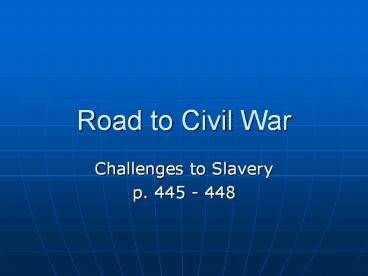Road to Civil War PowerPoint PPT Presentation
1 / 10
Title: Road to Civil War
1
Road to Civil War
- Challenges to Slavery
- p. 445 - 448
2
A New Political Party
- Even before Browns raid, other events had driven
the North and South further apart. - After the Kansas-Nebraska Act, the Democratic
Party began to divide along sectional lines, with
Northern Democrats leaving the party. - Differing views over the slavery issue destroyed
the Whig Party. - Antislavery Whigs and Democrats joined forces
with Free-Soilers to form the Republican Party.
3
A New Political Party
- The Republicans challenged the proslavery Whigs
and Democrats. - Their main message was that the government should
ban slavery from new territories. - The Republican Party quickly showed its strength
in the North. - In the South the Republicans had almost no
support.
4
The Dred Scott Decision
- Dred Scot was an enslaved African American bought
by an army doctor in Missouri, a slave state. - Later, the doctor moved to Illinois, a free
state, and then to the Wisconsin Territory, where
slavery was banned by the Northwest Ordinance of
1787. - Later the family returned to Missouri, where the
doctor died. - Dred Scott sued for his freedom.
- He claimed he should be free because he had once
lived on free soil.
5
(No Transcript)
6
The Courts Decision
- The Courts decision electrified the nation.
- Chief Justice Roger B. Taney said that Dred Scott
was still a slave. - As a slave, Scott was not a citizen and had no
right to bring a lawsuit. - Taney wrote that Scotts residence on free soil
did not make him free. - An enslaved person was property, and the Fifth
Amendment prohibits Congress from taking away
property without due process of law.
7
The Courts Decision
- Taney wrote that Congress had no power to
prohibit slavery in any territory. - The Missouri Compromise which had banned
slavery north of the 36-30N latitude was
unconstitutional and so was popular sovereignty. - Not even the voters in a territory could prohibit
slavery because that would amount to taking away
a persons property. - The decision meant that the Constitution
protected slavery.
8
Reaction to the Decision
- The Supreme Courts decision divided the country
even more. - The Court had reaffirmed what many in the South
had always maintained Nothing could legally
prevent the spread of slavery. - Northern Democrats were pleased that the
Republicans main issue restricting the spread
of slavery had been ruled unconstitutional. - Republicans and other antislavery groups were
outraged.
9
The Raid on Harpers Ferry
- Political tensions heightened after the election
of 1858. - Southerners felt threatened by growing Republican
power. - On October 16, 1859, the abolitionist John Brown
led 18 men on a raid on Harpers Ferry, Virginia. - His target was an arsenal, a storage place for
weapons and ammunition. - Brown and his men were quickly defeated by local
citizens and federal troops.
10
The Raid on Harpers Ferry
- Brown was convicted of treason and murder and
sentenced to hang. - John Browns death became a rallying point for
abolitionists. - When Southerners learned of Browns connection to
abolitionists, their fears of a great Northern
conspiracy against them seemed confirmed. - The nation was on the brink of disaster.

